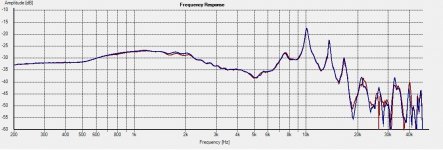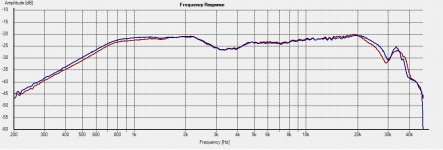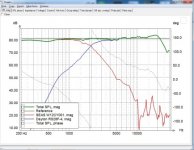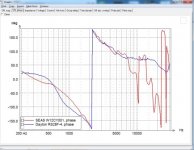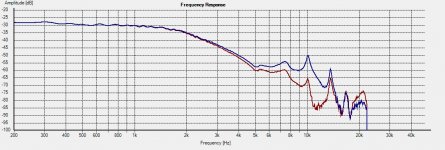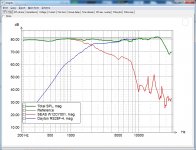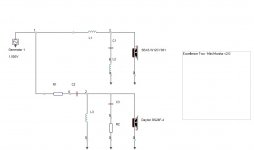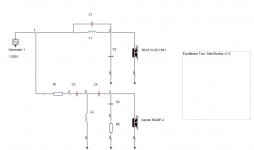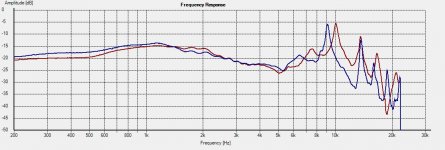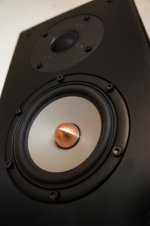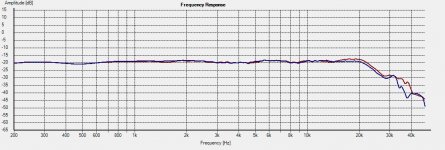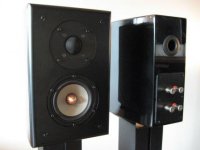
It’s time to start a new build thread.
Excellence Two – Mini Monitor is a mini sized 2-way stand-mount loudspeaker. It will use two very nice drivers from SEAS and Dayton Audio.
Here are my driver unit measurements:
SEAS W12CY001 SEAS E0021 W12CY001
Dayton RS28F-4 Dayton Audio RS28F-4
So far this driver unit combo looks very promising. I have done initial frequency measurements with my DEQX pre-amp. I’ve made some active filter configurations which I’m currently evaluating in order to get a feeling of how the drivers behave. I use my DEQX to break-in the drivers while listening to music and as soon as I have finished break-in I will do frequency and distortion measurements for the passive filter design.
For further details, take a look at:
Blog Archive Excellence Two - Mini Monitor Construction Update1!
Blog Archive Excellence Two - Mini Monitor Construction Update2!
Regards
/Göran
Goran, another interesting build.
Firstly, great website. Looking forward to reading about your other speakers.
Regarding this build, did you notch that 7kHz 10kHz break-up? In your description you wrote that you preferred a lower crossover point, but did not mention the crossover slope. One of the advantages of using a 4" midwoofer is to allow a higher crossover point and thus a smaller tweeter ie, avoiding the crossover in the "telephone band." I'm wondering if a notch and 2nd order slope at around 3500Hz would sound very good.
Firstly, great website. Looking forward to reading about your other speakers.
Regarding this build, did you notch that 7kHz 10kHz break-up? In your description you wrote that you preferred a lower crossover point, but did not mention the crossover slope. One of the advantages of using a 4" midwoofer is to allow a higher crossover point and thus a smaller tweeter ie, avoiding the crossover in the "telephone band." I'm wondering if a notch and 2nd order slope at around 3500Hz would sound very good.
Thank you for your kind wordsGoran, another interesting build.
Firstly, great website. Looking forward to reading about your other speakers.
Regarding this build, did you notch that 7kHz 10kHz break-up? In your description you wrote that you preferred a lower crossover point, but did not mention the crossover slope. One of the advantages of using a 4" midwoofer is to allow a higher crossover point and thus a smaller tweeter ie, avoiding the crossover in the "telephone band." I'm wondering if a notch and 2nd order slope at around 3500Hz would sound very good.
Yes, that would be true if the 4” mid-woofer was a well behaved non-hard cone driver, but using a metal cone driver with such a severe cone break-up as in this case in the 10kHz region will affect the distortion profile for this driver. We will have 3rd harmonics in the 3.3kHz region and 5th harmonics in the 2kHz region which we need to address and consider. How severe these are, I will have to wait and see until I’ve done distortion measurements.
I’ve seen examples of designs where SEAS 7” magnesium drivers has been crossed-over as high as 3-3.5kHz and even when using a notch filter, these will in my opinion sound awful and that’s why I think many people don’t like the SEAS magnesium drivers, simply because they aren’t optimally implemented.
One such example is the SEAS Thor kit. Despite the claimed cross-over point at 2.5kHz, they sound bad to my ears. I wouldn’t cross these 7” drivers higher than 1.6kHz if I was considering the distortion profile of this driver. However one exception would be if an active solution like the DEQX where used with very step cross-overs >96db/octave.
I will have to wait and see which cross-over point I end up with the W12 driver, but the quick active setup with my DEQX has indicated a low cross-over point. I’ve tested 48, 60, 96 and 192db/octave cross-overs filter slopes and since the DEQX works in the digital domain and do speaker correction it take cares of the frequency response (notching) at the cone break-up region.
I will hopefully find some time within a week to do distortion measurement and start the frequency measurements for the passive filter design, but I want play some more music on them so they are fully broken-in.
Regards
/Göran
Very nice Goran, & thanks for sharing. How does it compare to the SAL451?
Thank you!
I don’t know because I’ve haven’t done any passive filter design yet, but I think it will out-class the SAL451. Why? Simply because the tweeter used for this design is a much more better sounding driver than the SEAS 27TBFC/G tweeter and I will use a wider enclosure which lets the mid-woofer driver breathe more properly and at last the SEAS W12CY001 is a better driver than the SEAS L12RCY/P driver.
I will later on after I’ve finished the “Excellence Two – Mini Monitor” design a cheaper version “Prestigious Two – Mini Monitor” with the SEAS L12 mid-woofer, but the same Dayton tweeter.
Regards
/Göran
Distortion measurements:
I’ve done distortion measurements on the driver units used in the design. The measurements are consistent with my research and listening tests of the loudspeaker driver units.
Both drivers perform very well and especially the tweeter impresses me a lot. Considering the listening and measurement performance, the tweeter is a real bargain.
The distortion measurements are done in near-field and the amplifier output level was adjusted for each driver so that the fundamental is 85dB at 1m and 90dB at 1m. This setting simulates normal to medium-high listening levels.
The tweeter is very low distorting and it appears to have “copper” in all the right places in the motor design. With a proper filter design, this is one of the few tweeters that actually could work together with an 8” woofer in a 2-way. It can be crossed-over as low as 1.2kHz, if used properly.
The mid-woofer has the expected cone break-ups at 10kHz and 13.5kHz. These break-ups show up in the 3rd harmonics at 3.3kHz and 4.5kHz and at the 5th harmonics at 2kHz and 2.7kHz.
The active cross-over I’ve been using while breaking in the drivers is crossed-over at 1750Hz. My listening tests confirms that it’s a rational cross-over point. Together with a properly constructed notch filter, I wouldn’t use this driver higher than 2kHz in order to deal with cone break-ups properly. Somewhere between 1.7-2kHz seems doable.
For measurement details see:
Excellence Two – Mini Monitor Construction Update3!
Distortion measurement Dayton Audio RS28F-4
Distortion measurement SEAS E0021 W12CY001
Regards
/Göran
I’ve done distortion measurements on the driver units used in the design. The measurements are consistent with my research and listening tests of the loudspeaker driver units.
Both drivers perform very well and especially the tweeter impresses me a lot. Considering the listening and measurement performance, the tweeter is a real bargain.
The distortion measurements are done in near-field and the amplifier output level was adjusted for each driver so that the fundamental is 85dB at 1m and 90dB at 1m. This setting simulates normal to medium-high listening levels.
The tweeter is very low distorting and it appears to have “copper” in all the right places in the motor design. With a proper filter design, this is one of the few tweeters that actually could work together with an 8” woofer in a 2-way. It can be crossed-over as low as 1.2kHz, if used properly.
The mid-woofer has the expected cone break-ups at 10kHz and 13.5kHz. These break-ups show up in the 3rd harmonics at 3.3kHz and 4.5kHz and at the 5th harmonics at 2kHz and 2.7kHz.
The active cross-over I’ve been using while breaking in the drivers is crossed-over at 1750Hz. My listening tests confirms that it’s a rational cross-over point. Together with a properly constructed notch filter, I wouldn’t use this driver higher than 2kHz in order to deal with cone break-ups properly. Somewhere between 1.7-2kHz seems doable.
For measurement details see:
Excellence Two – Mini Monitor Construction Update3!
Distortion measurement Dayton Audio RS28F-4
Distortion measurement SEAS E0021 W12CY001
Regards
/Göran
Last edited:
Frequency Measurements:
This weekend I have made frequency measurements for the “Excellence Two – Mini Monitor” and the measurements look good. Both the mid-woofers and the tweeters measures as expected and each sample are a close match to each other and the build consistency seems to be very good.
The mid-woofer has cone break-ups at 10kHz and 13.5kHz. These break-ups are visible in the distortion measurements and have to be eliminated in the cross-over design with a notch filter centered at the stronger break-up at 10kHz. They have a very smooth mid-range frequency response up to 2kHz where it starts to roll-off and does so without any visible cone-edge resonances. A 3-4dB BSC (Baffle Step Compensation) seems to be a good starting point to test with these mid-woofers.
The tweeter has a nice smooth frequency response with a slightly rising top-end response at the on-axis measurement. The baffle diffraction is noticeable at 3.5kHz as a mild dip in the frequency response. This dip flattens out as the off-axis angle increase and is gone at a 30 degree angle.
Now the fun begins when I have all the data to begin the cross-over simulation.
Sample 1 = Blue
Sample 2 = Red
For further details see:
Excellence Two – Mini Monitor Construction Update4!
Driver Unit Measurements – SEAS E0021 W12CY001
Driver Unit Measurements – Dayton Audio RS28F-4
Regards
/Göran
This weekend I have made frequency measurements for the “Excellence Two – Mini Monitor” and the measurements look good. Both the mid-woofers and the tweeters measures as expected and each sample are a close match to each other and the build consistency seems to be very good.
The mid-woofer has cone break-ups at 10kHz and 13.5kHz. These break-ups are visible in the distortion measurements and have to be eliminated in the cross-over design with a notch filter centered at the stronger break-up at 10kHz. They have a very smooth mid-range frequency response up to 2kHz where it starts to roll-off and does so without any visible cone-edge resonances. A 3-4dB BSC (Baffle Step Compensation) seems to be a good starting point to test with these mid-woofers.
The tweeter has a nice smooth frequency response with a slightly rising top-end response at the on-axis measurement. The baffle diffraction is noticeable at 3.5kHz as a mild dip in the frequency response. This dip flattens out as the off-axis angle increase and is gone at a 30 degree angle.
Now the fun begins when I have all the data to begin the cross-over simulation.
Sample 1 = Blue
Sample 2 = Red
For further details see:
Excellence Two – Mini Monitor Construction Update4!
Driver Unit Measurements – SEAS E0021 W12CY001
Driver Unit Measurements – Dayton Audio RS28F-4
Regards
/Göran
Attachments
great job, my compliments !!
Thank You!
The "Excellence Two - Mini Monitor" design is progressing nicely.
My website will fill up with a lot more driver measurements and designs over time, but it's hard to find the time to write everything down.
Right now I'm considering if I will publish driver unit measurements of drivers that's not part of the current designs, but might possibly be interesting for people to read about.
Regards
/Göran
Excellence Two – Mini Monitor Construction Update!
I’ve begun with the cross-over simulations based on the frequency measurements I did last weekend. So far everything is going well and it was quite easy to simulate the first prototype cross-over design, which I will build, measure and listen to.
There are a couple of challenges to deal with in this design. First of all the mid-woofer cone break-up needs to be taken care of properly. I will use steep cross-over slopes (24dB/octave acoustical) and a notch filter to reduce the 10kHz break-up mode.
I’m not fully satisfied with the conventional LCR notch approach, instead I will try an alternative method to deal with the break-up and to reduce the complexity of the filter. Distortion measurements and listening tests will decide which method I will use.
Second, I have to deal with the tweeters rising top-end response and how much attenuation it needs in order to get a well-balanced sound that doesn’t sound to bright, but still manage to present an open and airy sound.
For further details see:
Excellence Two – Mini Monitor Construction Update5!
Regards
/Göran
I’ve begun with the cross-over simulations based on the frequency measurements I did last weekend. So far everything is going well and it was quite easy to simulate the first prototype cross-over design, which I will build, measure and listen to.
There are a couple of challenges to deal with in this design. First of all the mid-woofer cone break-up needs to be taken care of properly. I will use steep cross-over slopes (24dB/octave acoustical) and a notch filter to reduce the 10kHz break-up mode.
I’m not fully satisfied with the conventional LCR notch approach, instead I will try an alternative method to deal with the break-up and to reduce the complexity of the filter. Distortion measurements and listening tests will decide which method I will use.
Second, I have to deal with the tweeters rising top-end response and how much attenuation it needs in order to get a well-balanced sound that doesn’t sound to bright, but still manage to present an open and airy sound.
For further details see:
Excellence Two – Mini Monitor Construction Update5!
Regards
/Göran
Attachments
Excellence Two – Mini Monitor Construction Update6!
I’ve built the first prototype of the cross-over and made some distortion and mid-woofer near-field frequency measurements with the focus on the cone break-up behavior.
The mid-woofer cross-over section is made of a simple 2nd order electrical filter in order to achieve a 4th order LR cross-over slope at 2000Hz. For the notch filter section a cap shunt over the series coil is used to reduce the cone break-up at 10kHz.
Thanks to the relatively low cross-over frequency the odd-order distortions are low, even at higher listening levels. But don't be fooled by the distortion measurements alone, the cone break-up is very audible and a notch filter is a must.
The notch filter reduces the break-up with an additional 15dB and the effect is clearly visible in the frequency measurements (see picture1).
A brief listening test to the prototype cross-over suggests that some work needs to be done at the tweeter section in order to find the proper balance between the mid and highs and the tweeter level.
For further details see:
Excellence Two – Mini Monitor Construction Update6!
Regards
/Göran
I’ve built the first prototype of the cross-over and made some distortion and mid-woofer near-field frequency measurements with the focus on the cone break-up behavior.
The mid-woofer cross-over section is made of a simple 2nd order electrical filter in order to achieve a 4th order LR cross-over slope at 2000Hz. For the notch filter section a cap shunt over the series coil is used to reduce the cone break-up at 10kHz.
Thanks to the relatively low cross-over frequency the odd-order distortions are low, even at higher listening levels. But don't be fooled by the distortion measurements alone, the cone break-up is very audible and a notch filter is a must.
The notch filter reduces the break-up with an additional 15dB and the effect is clearly visible in the frequency measurements (see picture1).
A brief listening test to the prototype cross-over suggests that some work needs to be done at the tweeter section in order to find the proper balance between the mid and highs and the tweeter level.
For further details see:
Excellence Two – Mini Monitor Construction Update6!
Regards
/Göran
Attachments
Excellence Two – Mini Monitor Construction Update7!
I’ve scrapped the v1.0 of the cross-over. After listen to the v1.0 cross-over for a while it was clear that it sounded good, but not great.
I did some new simulations and decided to change from a 4th order to a 2nd order topology and quickly rebuilt the cross-over to a v2.0.
Now the mid-range opened up considerably and I think I’m on the right track again. More listening tests, measurements and fine tuning is needed, but I’m finally nearing the final design.
For further details see:
Excellence Two – Mini Monitor Construction Update7!
Picture1: Cross-over v1.0
Picture2: Cross-over v2.0
Picture3: Cross-over simulation - 15deg off-axis
Regards
/Göran
I’ve scrapped the v1.0 of the cross-over. After listen to the v1.0 cross-over for a while it was clear that it sounded good, but not great.
I did some new simulations and decided to change from a 4th order to a 2nd order topology and quickly rebuilt the cross-over to a v2.0.
Now the mid-range opened up considerably and I think I’m on the right track again. More listening tests, measurements and fine tuning is needed, but I’m finally nearing the final design.
For further details see:
Excellence Two – Mini Monitor Construction Update7!
Picture1: Cross-over v1.0
Picture2: Cross-over v2.0
Picture3: Cross-over simulation - 15deg off-axis
Regards
/Göran
Attachments
New driver unit measurements!
I have released new driver unit measurements on the L12RCY/P used in the “Prestigious Two – Mini Monitor” loudspeaker.
“Prestigious Two – Mini Monitor” is a less expensive alternative to the “Excellence Two – Mini Monitor” design. The SEAS 4.5” mid-woofers used in these two designs are more alike than different from each other.
The L12RCY/P: has 1-1.5dB higher sensitivity and the cone break-up occurs at a lower frequency, 9.2kHz instead of 10kHz for the W12CY001. The W12CY001 also has a bit lower distortion profile and a greater bass extension. Besides that they are very similar drivers.
For further details see:
www.audioexcite.com SEAS H1207 L12RCY/P
Picture:
Blue = L12RCY/P
Red= W12CY001
I have released new driver unit measurements on the L12RCY/P used in the “Prestigious Two – Mini Monitor” loudspeaker.
“Prestigious Two – Mini Monitor” is a less expensive alternative to the “Excellence Two – Mini Monitor” design. The SEAS 4.5” mid-woofers used in these two designs are more alike than different from each other.
The L12RCY/P: has 1-1.5dB higher sensitivity and the cone break-up occurs at a lower frequency, 9.2kHz instead of 10kHz for the W12CY001. The W12CY001 also has a bit lower distortion profile and a greater bass extension. Besides that they are very similar drivers.
For further details see:
www.audioexcite.com SEAS H1207 L12RCY/P
Picture:
Blue = L12RCY/P
Red= W12CY001
Attachments
Excellence Two – Mini Monitor Released!
I have now released the design for the "Excellence Two – Mini Monitor" and the details can be found at:
Excellence Two – Mini Monitor | AudioExcite Loudspeaker Design
Soon I will also release the "Prestigious Two – Mini Monitor" which is the less expensive cousin of the "Excellence Two – Mini Monitor".
They are virtually the same loudspeaker design, but the Prestigious loudspeaker uses the aluminium cone mid-woofer SEAS L12RCY/P instead of the magnesium cone mid-woofer SEAS W12CY001.
The "Excellence Two – Mini Monitor" is a very nice sounding small loudspeaker that can play some serious bass for its size. It has a generous soundstage and sounds clear and detailed, but without sounding analytical.
There are several tweeter level options in order to adjust the tonal balance according to personal taste and HiFi equipment.
Picture2: Left vs. right loudspeaker @ tweeter reference level (0dB attenuation)
Regards
/Göran
I have now released the design for the "Excellence Two – Mini Monitor" and the details can be found at:
Excellence Two – Mini Monitor | AudioExcite Loudspeaker Design
Soon I will also release the "Prestigious Two – Mini Monitor" which is the less expensive cousin of the "Excellence Two – Mini Monitor".
They are virtually the same loudspeaker design, but the Prestigious loudspeaker uses the aluminium cone mid-woofer SEAS L12RCY/P instead of the magnesium cone mid-woofer SEAS W12CY001.
The "Excellence Two – Mini Monitor" is a very nice sounding small loudspeaker that can play some serious bass for its size. It has a generous soundstage and sounds clear and detailed, but without sounding analytical.
There are several tweeter level options in order to adjust the tonal balance according to personal taste and HiFi equipment.
Picture2: Left vs. right loudspeaker @ tweeter reference level (0dB attenuation)
Regards
/Göran
Attachments
Great work. Thanks for posting your design. I like the approach of using shallower crossover slopes. Of course it helps when you have the proper drivers to do so. I have used the Dayton tweeter before and I know it can handle it.
Looking forward to your 3-way design. Keep up the good work.
Looking forward to your 3-way design. Keep up the good work.
Great work. Thanks for posting your design. I like the approach of using shallower crossover slopes. Of course it helps when you have the proper drivers to do so. I have used the Dayton tweeter before and I know it can handle it.
Thank you!
In this design I think the shallower sloped cross-over worked better. When I used a steeper slopes with these SEAS mid-woofers they somehow lost some of their unique character and sound quality. When using hard cone drivers like these mid-woofers the trick is no deal with the cone break-up correctly and with a carefully tuned notch-filter it works.
Looking forward to your 3-way design. Keep up the good work.
I haven't done any work on the 3-way yet, but I'm still sketching it up in my head.
 I'm still considering if I would use ScanSpeak or AudioTechnology mid-ranges and woofers. There might also be a bit more scaled down 3-way version than first planned, but with several different tweeter options.
I'm still considering if I would use ScanSpeak or AudioTechnology mid-ranges and woofers. There might also be a bit more scaled down 3-way version than first planned, but with several different tweeter options. Time will tell and I haven't decided yet.
Regards
/Göran
Last edited:
- Status
- This old topic is closed. If you want to reopen this topic, contact a moderator using the "Report Post" button.
- Home
- Loudspeakers
- Multi-Way
- Excellence Two – Mini Monitor
